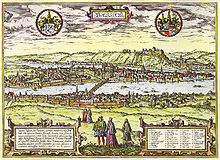Passau (German: [ˈpasaʊ] ; Central Bavarian: Båssa) is a city in Lower Bavaria, Germany, also known as the Dreiflüssestadt ("City of Three Rivers") as the river Danube is joined by the Inn from the south and the Ilz from the north.
Passau's population is approx. 50,000, of whom about 12,000 are students at the University of Passau, renowned in Germany for its institutes of economics, law, theology, computer science and cultural studies.
In the 2nd century BC, many of the Boii tribe were pushed north across the Alps out of northern Italy by the Romans. They established a new capital called Boiodurum by the Romans (from Gaulish Boioduron), now within the Innstadt district of Passau.[1]
Passau was an ancient Roman colony called Batavis, Latin for "for the Batavi." The Batavi were an ancient Germanic tribe often mentioned by classical authors, and they were regularly associated with the Suebian marauders, the Heruli. Batavis (Passau-Altstadt) was a Roman castrum in the province of Raetia, while another late Roman castrum, Boiotro (Passau-Innstadt), was in the province of Noricum.
During the second half of the 5th century, St. Severinus established a monastery here. The site was subject to repeated raids by the Alemanni.[2] In 739, the recently consecrated English archbishop Boniface founded the diocese of Passau, which for many years was the largest diocese of the German Kingdom/Holy Roman Empire, covering territory in southern Bavaria and most of what is now Upper and Lower Austria. From the 10th century the bishops of Passau also exercised secular authority as Prince-Bishops in the immediate area around Passau (see Prince-Bishopric of Passau).
 Passau c. 1581
Passau c. 1581In the Treaty of Passau (1552), Archduke Ferdinand I, representing Emperor Charles V, secured the agreement of the Protestant princes to submit the religious question to a diet. This led to the Peace of Augsburg in 1555.
During the Renaissance and early modern period, Passau was one of the most prolific centres of sword and bladed weapon manufacture in Germany (after Solingen). Passau smiths stamped their blades with the Passau wolf, usually a rather simplified rendering of the wolf on the city's coat-of-arms. Superstitious warriors believed that the Passau wolf conferred invulnerability on the blade's bearer, and thus Passau swords acquired a great premium. According to the Donau-Zeitung, aside from the wolf, some cabalistic signs and inscriptions were added.[3] As a result, the whole practice of placing magical charms on swords to protect the wearers came to be known for a time as "Passau art". (See Eduard Wagner, Cut and Thrust Weapons, 1969.) Other cities' smiths, including those of Solingen, recognized the marketing value of the Passau wolf and adopted it for themselves. By the 17th century, Solingen was producing more wolf-stamped blades than Passau was.
In 1662, a devastating fire consumed most of the city. Passau was subsequently rebuilt in the Baroque style.
Passau was secularised and divided between the Electorate of Bavaria and the Electorate of Salzburg in 1803. The portion belonging to Salzburg became part of Bavaria in 1805.
 Passau 1892
Passau 1892From 1892 until 1894, Adolf Hitler and his family lived in Passau.[4] The city archives mention Hitler being in Passau on four occasions in the 1920s for speeches. In addition, Heinrich Himmler spent some time there.
In November 1933, the building of Nibelungenhalle (Hall of the Nibelungs) was announced. Intended to hold 8,000 to 10,000 guests, and another 30,000 in front of it, in 1935 the hall also became quarters for a unit of the Austrian Legion.[5] Beginning in 1934, these troops had occupied a building that belonged to Sigmund Mandl, a Jewish merchant. That building, in turn, was referred to as SA barracks.[6]</ref>
Beginning in 1940, Passau offered the building at Bräugasse 13 to Volksdeutsche Mittelstelle.[7]
During World War II, the city also housed three sub-camps of the infamous Mauthausen-Gusen concentration camp: Passau I (Oberilzmühle),[8] Passau II (Waldwerke Passau-Ilzstadt) and Passau III (Jandelsbrunn). From January to May 1945, refugees from East Prussia and Silesia passed the city, after May, as the result of ethnic cleansing of neighboring Bohemia and Moravia of their German populace, further waves of refugees arrived in the city.[9]
On 3 May 1945 a message from Major General Stanley Eric Reinhart’s 261st Infantry Regiment stated at 3:15 am: "AMG Officer has unconditional surrender of PASSAU signed by Burgermeister, Chief of Police and Lt. Col of Med Corps there. All troops are to turn themselves in this morning."
It was the site of a post World War II American sector displaced persons camp.
 High-water scale 1501–2002 at Passau as of September 2012
High-water scale 1501–2002 at Passau as of September 2012On 2 June 2013, the old town suffered from severe flooding as a result of several days of rain and its location at the confluence of three rivers.[10] Peak elevations of floods as early as 1501 are displayed on a wall at the Old City Hall.[11] Flood water reaches the base of that wall on average once every 5 years.[11]: 19
































Add new comment